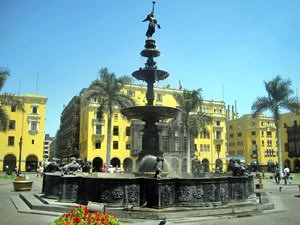 Peruvian cuisine combines the traditions of indigenous people and the traditions of migrants who went to conquer a new country in search of gold and a better life. Local products form the basis of Peruvian cuisine. This is corn, potatoes, various tubers, legumes, and Amaranthaceae – quinoa, kanihua, and kiwicha. The Spaniards who conquered Peru supplemented these products with rice, wheat, and meat (beef, pork, and chicken). Quinoa and kiwicha is rich in protein cereals. They are extremely useful for health. These cereals have become very popular among fans of a healthy lifestyle in recent years. Many grains, legumes, and tubers that are still considered exotic in Europe grow in Peru. This is tarvi, lima, a mashua, and ullucus. Chili peppers, potatoes, and tomatoes were imported to Europe from Peru. There are 2,500 types of potatoes alone. All these products are used in local cuisine. Bread is not popular in Peru. It is replaced with different tortillas. Pies with different fillings are popular.
Peruvian cuisine combines the traditions of indigenous people and the traditions of migrants who went to conquer a new country in search of gold and a better life. Local products form the basis of Peruvian cuisine. This is corn, potatoes, various tubers, legumes, and Amaranthaceae – quinoa, kanihua, and kiwicha. The Spaniards who conquered Peru supplemented these products with rice, wheat, and meat (beef, pork, and chicken). Quinoa and kiwicha is rich in protein cereals. They are extremely useful for health. These cereals have become very popular among fans of a healthy lifestyle in recent years. Many grains, legumes, and tubers that are still considered exotic in Europe grow in Peru. This is tarvi, lima, a mashua, and ullucus. Chili peppers, potatoes, and tomatoes were imported to Europe from Peru. There are 2,500 types of potatoes alone. All these products are used in local cuisine. Bread is not popular in Peru. It is replaced with different tortillas. Pies with different fillings are popular.
Every region in Peru is characterized by its unique nature landscape. In this country one will find lifeless desert, snowcapped mountains and dense …
Read further
Read further
About 30 million people live in Peru. Most of them live in cities. 60% of the population is so-called mestizos. They are people of combined Spanish …
Read further
Read further
 Several thousand Japanese workers arrived in Peru at the end of the XIX century. Many of them stayed in a warm, friendly country after they worked out their contracts. They brought with them the culinary traditions of their country. But unfortunately, some of the ingredients were not available in Peru. The Japanese began to look for replacements among local products. So another branch of Peruvian cuisine appeared. It is called Nikkei after the nickname of Japanese migrants in Peru.
Several thousand Japanese workers arrived in Peru at the end of the XIX century. Many of them stayed in a warm, friendly country after they worked out their contracts. They brought with them the culinary traditions of their country. But unfortunately, some of the ingredients were not available in Peru. The Japanese began to look for replacements among local products. So another branch of Peruvian cuisine appeared. It is called Nikkei after the nickname of Japanese migrants in Peru.
The heritage of the Incas and pre-Inca states most of all attract tourists to Peru. Ruins of temples, palaces and residential buildings of highly …
Read further
Read further
 Tostaditas corn tortillas are a typical Nikkei dish. They are served with different sauces. Sushi is also popular here. They are often prepared with unusual ingredients, including fruits, berries, peppers, and different kinds of local sauces. For example, Yuzukoshō is a sauce made from yuzu (a citrus fruit), chili pepper, and salt. It's very spicy. Sometimes rice is replaced with sweet potatoes or local cereals in sushi. Ponzu is made from citrus juice, soy sauce, wine, white rice vinegar, and dashi broth (a broth of kombu seaweed infused with tuna shavings).
Tostaditas corn tortillas are a typical Nikkei dish. They are served with different sauces. Sushi is also popular here. They are often prepared with unusual ingredients, including fruits, berries, peppers, and different kinds of local sauces. For example, Yuzukoshō is a sauce made from yuzu (a citrus fruit), chili pepper, and salt. It's very spicy. Sometimes rice is replaced with sweet potatoes or local cereals in sushi. Ponzu is made from citrus juice, soy sauce, wine, white rice vinegar, and dashi broth (a broth of kombu seaweed infused with tuna shavings).
Nightlife in Peru is concentrated in large cities, mainly in Lima and Cusco. There are many high-class clubs with good music and drinks in Lima. They …
Read further
Read further
 Peruvian cuisine also varies from region to region. Fish and seafood are the main dishes on the coast. River fishes are popular in the jungle. Llama and Alpaca steaks, lamb, and potatoes are most commonly eaten in the Andes.
Peruvian cuisine also varies from region to region. Fish and seafood are the main dishes on the coast. River fishes are popular in the jungle. Llama and Alpaca steaks, lamb, and potatoes are most commonly eaten in the Andes.
1. Peru is located in several climate zones. Therefore, the climate is very diverse here. Winter and summer are relative concepts. The costa stretches …
Read further
Read further


